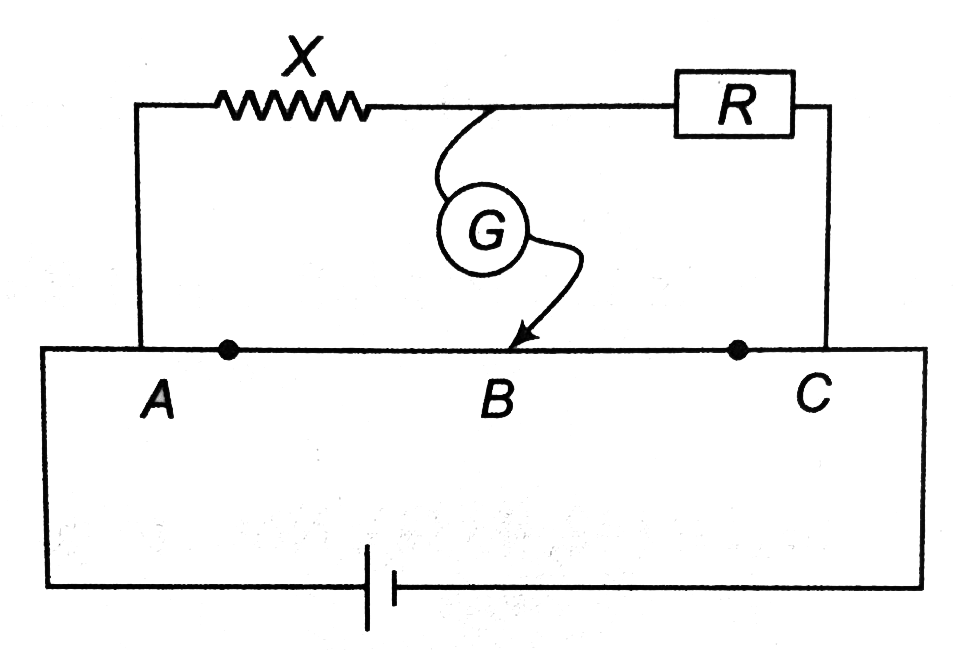R1,R2,R3 are different values R.A,B and C are the null points obtained corresponding to R1,R2andR3 respectively. For which resistor, the value of R will be the most accurate and why?
 .
.
Resistance R1
Resistance R2
Resistance R3
All the three (R1,R2,R3) will give the same accuracy
The correct Answer is:B
The accuracy is maximum for resistance R2. For maximum accuracy the null point should be near the centre.
Topper's Solved these Questions
Similar Questions
R1,R2,R3 are different values R,A,B and C are the null points obtained corresponding to R1,R2andR3 respectively. For which resistor, the value of X will be the most accurate and why?
 .
.
View SolutionR1,R2,R3 are different values of R,A,B and C are the null points obtained corresponding to R1,R2 and R3 respectively. For which resistor, the value of X will be the most accurate and why?

View Solution
Knowledge Check
In a △ABC, the inradius and three exradii are r,r1,r2 and r3 respectively. In usual notations the value of r.r1.r2.r3 is equal to
A2△B△2Cabc4RDNone of theseFor ensuring dissipation of same energy in all three resistors (R1,R2,R3) connected as shown in figure, their values must be related s
 AR1=R2=R3BR2=R3 and R1=4R2CR2=R3 and R1=14R2DR1=R2+R3
AR1=R2=R3BR2=R3 and R1=4R2CR2=R3 and R1=14R2DR1=R2+R3Three resistors R1,R2 and R3 are to be combined to form an electrical circuit as shown in the figure. It is found that when R1R2andR3 are put respectively in positions A, B and C, the effective resistance of the circuit is 70 ΩWhen R2,R3andR1 are put respectively in position A, B and C the effective resistance is 35Ω and when R3,R1andR2 are respectively put in the position A, B and C, the effective resistance is 42Ω
If R1,R2andR3 are all connected in parallel, the effective resistance will beA37ΩB72ΩC50//7OmegaD607Ω
Major product obtained in the following reaction r1,r2andr3 in respectively is :-

View Solution5 resistances R1,R2,R3,R4,R5 are joined as shown in the figure.

The values of R1,R2,R3andR4 are so adjusted that the current in the circuit does not change for any value of the resistance R5. This is possible for the following relation
View SolutionThree resistors R1,R2 and R3 are to be combined to form an electrical circuit as shown in the figure. It is found that when R1R2andR3 are put respectively in positions A, B and C, the effective resistance of the circuit is 70 ΩWhen R2,R3andR1 are put respectively in position A, B and C the effective resistance is 35Ω and when R3,R1andR2 are respectively put in the position A, B and C, the effective resistance is 42Ω
The resistanceR1:R2:R3are in the ratio
View SolutionThree resistors R1,R2 and R3 are to be combined to form an electrical circuit as shown in the figure. It is found that when R1R2andR3 are put respectively in positions A, B and C, the effective resistance of the circuit is 70 ΩWhen R2,R3andR1 are put respectively in position A, B and C the effective resistance is 35Ω and when R3,R1andR2 are respectively put in the position A, B and C, the effective resistance is 42Ω
IfR_(1), R_(2)and R,_(3)are put in series, the effective resistance will be
View SolutionIn an electric circuit three resistors R1,R2andR3 are connected in series such that R2=R3. IF V1,V2andV3 are the voltage across R1,R2andR3 respectively , then
View Solution

